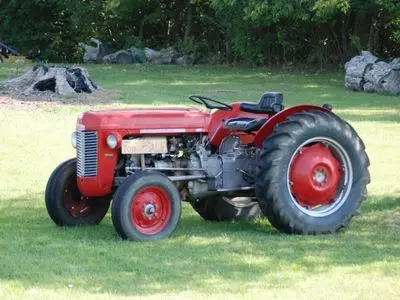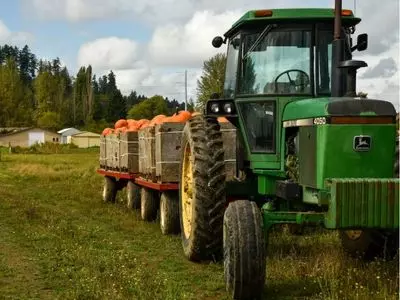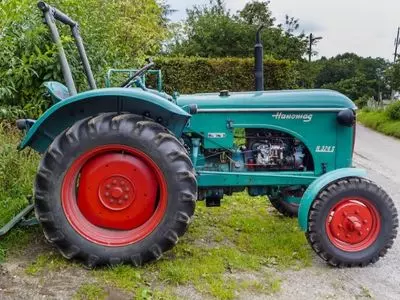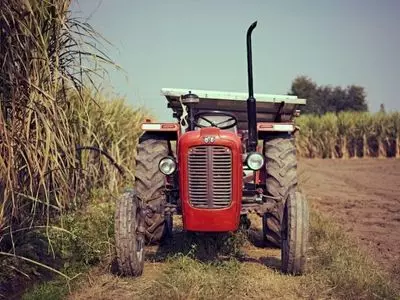No products in the cart.
Tractor
How To Drive A Tractor – GUIDE for First-Time Users
Tractors make the tasks of farming much easier and more efficient and vary in size and engine power so that you can find the right one for your farming needs.
Common tractor tasks include: hauling (with a bucket), snow removal (with an attached plow or blower), lifting (big logs, small dead trees, other heavy things), moving (with wood, stone, or mulch), and mowing (with a mower deck). In rural areas, it serves as an invaluable multipurpose tool.
While driving a tractor isn’t extremely challenging, it’s not the same as driving a family vehicle. You’ll be in command of a large vehicle that, if driven carelessly, might cause significant damage to yourself or others.
Here are some tips on how to drive a tractor safely!
*This post may have affiliate links, which means I may receive commissions if you choose to purchase through links I provide (at no extra cost to you). As an Amazon Associate I earn from qualifying purchases. Please read my disclaimer for additional details.
Tractor Inspection

Assess the Safety of the Tractor
It’s always a good idea to take a quick walk around your tractor before you get on it and begin to drive. Sometimes, you may need to retighten wheel lugs, nuts, or bolts.
Make Sure the Tractor’s Tires Have Adequate Air
Low tire pressure may jeopardize your tractor’s stability, which could endanger you and those on the road (if you need to use the road to travel between fields).
Even if you don’t use your tractor every day, you should inspect the tires before heading into a field to ensure they’re in good working order.
Check That the Stabilizer Chains Are Secure and in Place
This should be done by dragging any kind of attachments behind the tractor to check that it can fully and safely tow things.
Pull the Cover Off Your Tractor
Make sure the temperature control, radiator, and battery levels are fine. You’ll also need to ensure that you have enough oil and gas to complete the task at hand.
Maintain a Zero-Risk Environment at All Times
Wearing a wide-brimmed sunhat, gloves, and sturdy footwear will help keep you safe while operating a tractor.
While driving a tractor, avoid wearing loose clothing or jewelry that may get caught in moving parts.
Always use the tractor for its intended purpose and don’t push it beyond its limits. Horseplay can lead to significant injury and even death.
NEVER allow children, pets, or anyone else to come near the tractor while it’s in operation. If you do, it could be a deadly mistake.
Driving the Tractor

Get in the Driver’s Seat
After you ensure everything is safe, hop on the tractor and get in the driver’s seat.
Find the clutch and get used to its controls and ensure that your hands and feet can easily reach the vehicle’s wheel, throttle, and other controls.
Always Buckle Up When in Operation or Traveling Near Cars
We’re all used to wearing a seat belt when we’re in a car, but it may be tempting to pass up on buckling up in a slow tractor.
However, having the safety roll bar in place can prevent serious injury. Safe driving while operating a tractor is therefore crucial and should always be kept in mind.
Here are some statistics from the National Ag Safety Database:
- Rollovers, where the tractor overturns on the driver, cause approximately 130 deaths each year.
- Collisions with cars are the cause of death for about 60 people each year.
- Runovers, where the operator or another person is crushed by a moving tractor, cause about 50 deaths each year.
While injury and death while operating a tractor are fairly rare, they still happen, and they can happen to you. Buckling up and buying a tractor with a cage or cabin can significantly reduce your chances of serious or fatal injury.
Depress the Clutch Pedal
The engine must not be started until the transmission is neutral so use your left foot to depress the clutch pedal all the way to the floor.
With Your Right Foot, Step On the Brake
When the key is moved into the “on” position, the engine may be started.
Allow some time for the engine to warm up when starting tractors, especially in the winter. It can be dangerous to switch from turning a key to driving right away.
To Start Driving, You Must First Release the Parking Brake
While driving, keep your foot on the clutch and shift into first gear.
With Caution, Release Your Foot From the Clutch
The driver should then ease off the accelerator and let the tractor roll to a complete stop before shifting into neutral. The clutch should be in neutral.
Continue with caution while driving a manual transmission. It’s much easier not to have to apply the gas. Hold the gas pedal flat against the floor and remove the parking brake.
Keep Your Pace Constant and Slow
Tractors aren’t designed for speed; they’re built to be robust and long-lasting. Don’t put too much strain on the tractor.
Take care when driving around turns and hills. When making a turn, go very slowly, especially if you’re using tools or other equipment.
Tractor Stopping Requires a Full Press of the Clutch
To reduce your speed, take your foot off the gas pedal. To stop the tractor engine, turn the key to the “off” position.
After putting the vehicle in neutral and engaging the parking brake, you may exit the tractor.
Here’s a video that shows you how to safely drive a tractor:
Precautions to Take

A tractor is a necessary tool for many farming operations. However, it also has some inherent dangers that must be recognized and avoided.
When operating a tractor, remember the following safety guidelines:
- To purchase the right tractor for your needs, you must familiarize yourself with terminology related to tractors and understand the difference between various types of tractors.
- Only one person must occupy the tractor’s driver seat for the driver’s safety and those around them. Disregarding this could result in accidents or injuries.
- The longevity and safety of a tractor are contingent on maintaining it regularly.
- Rollover Protection Mechanism (ROP) – This system prevents tractors from sudden rollovers and overturns, thereby saving the operator’s life as well as avoiding vehicle damage.
- It’s also a fantastic idea to read the tractor operator’s handbook, which will include thorough information about the tractor and how to use it.
- If you’re operating your tractor in the evening hours, make sure you have noticeable lights or reflective gear.
Tips to Keep in Mind While Driving a Tractor
If you’re trying to learn how to operate a tractor by hand, keep in mind the following instructions:
- Don’t forget to follow local laws and rules when driving a tractor.
- Don’t put too much weight on your tractor.
- Use signals to alert roadway drivers of oncoming traffic, and if you can, drive in the grass.
- Don’t divert your attention away from the road by looking at anything else.
- To retain control of your tractor when making a turn, drive slowly.
Read More: 3 Point Hitch Attachments. We listed the top 3-point hitch attachments for your tractor that can handle the toughest tasks on the farm!
Conclusion
Knowing how to drive a tractor is only the first step. It’s just as important, if not more so, to prioritize safety and follow all the rules.
That way, you can avoid accidents or problems using your tractor. So be sure to keep all of these precautions and pieces of advice in mind and remember to drive safe!

